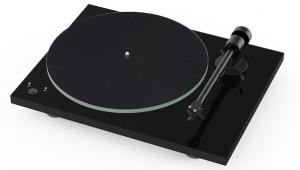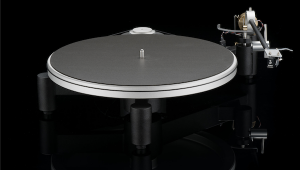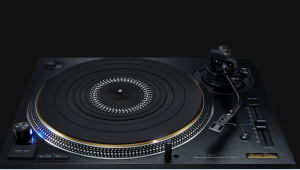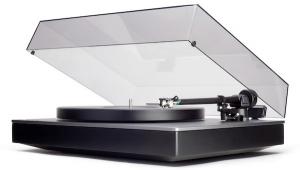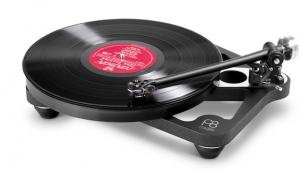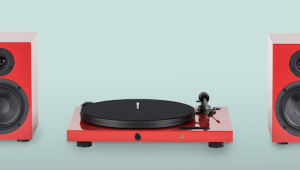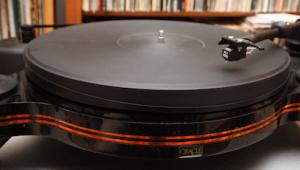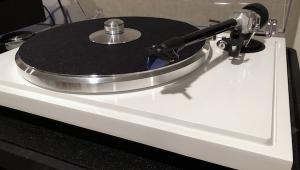The Thorens TD402 DD Direct Drive Semi-Automatic Turntable
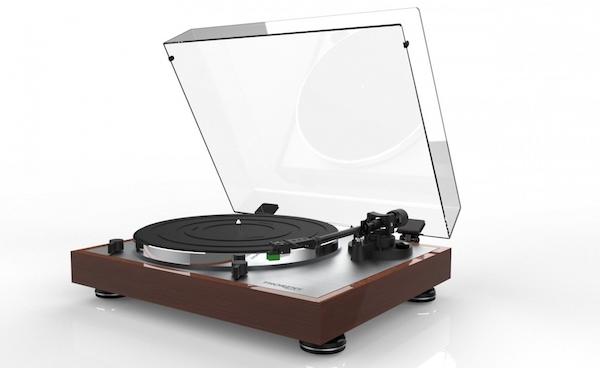
Unfortunately, the CD-era created the usual pressures upon the company and in 2000 it was denied bankruptcy protection and in 2002 back in Switzerland it became Thorens Services Ltd., but to manufacture “tsotchkes” (lighters, razors, lighters, etc.) not turntables.
As the vinyl resurgence grew Thorens was resurrected by Mr. Heinz Rohrer again as a Switzerland-based company. Mr. Rohrer organized a series of splashy debut events to which members of the press were invited, including a memorable visit to the restored magnificent Dresden Opera House that some claimed had been “spite-bombed” by the Allies during the waning days of World War II.
Mr. Rohrer worked hard to restore the brand’s luster but it was a difficult task, especially since Mr. Rohrer had resurrected a brand name, more than a turntable factory.
At one point at a lavish Munich area event Rohrer introduced us to a recently hired turntable designer who unveiled an ambitious prototype that to many in attendance promised to fully restore the Thorens name to the upper echelons of turntable manufacturers. Unfortunately, that product never materialized.
Thereafter Thorens designed, built and marketed a series of turntables at various price points, including some that resurrected the classic sprung subchassis designs. Those include the ambitious TD 550 and the TD 907.
Last year Thorens returned to Germany, reorganized as Thorens GMbH under new CEO Gunter Kürten—an audio industry veteran and former CEO of ELAC. While many charge that Thorens is more a marketing company than a designer and manufacturer of turntables, it does and has had a design team that works with companies like Pro-Ject and the German company that currently builds turntables under the Dual name among others.
Unfortunately, over the past decade or so, the company’s precise manufacturing history became somewhat cloudy. In other words, among the company’s many offerings, it’s not clear who makes what or from where the parts are sourced.
However, the $1099.99 TD402 DD, a direct drive turntable featuring auto-start and stop, a switchable moving magnet phono preamp, a carbon fiber arm tubed tonearm fitted with a pre-installed AT VM95E ($50 retail) cartridge and a hinged dust cover is manufactured to Thorens’ specifications in Taiwan at the same high quality factory that manufactures for a variety of other turntable brands.
The TD402 DD has a high quality Thorens “look” including a glossy rosewood frame and a brushed aluminum top plate. The base sits on four elastomer-based feet. The die-cast platter weighs a relatively light 1.5 pounds, topped with a thick ribbed rubber Thorens badged mat. One cannot fault the TD402 DD’s cosmetics.
Easy Set-Up And Use
Thorens has designed an easy to use “plug and play” turntable that includes an excellent “old school” glossy perfect-bound manual. The ‘table sets up in minutes. Unbox, put the platter with rubber mat on the spindle, set the tracking force and anti-skating and you’re almost ready to play records. All you need to do is choose on the back panel whether or not you want to use the built-in MM phono preamp and choose the “auto-on” feature or not. “On” means when you move the arm towards the platter, it begins spinning automatically. At the end of play the platter stops, though it takes more than a few revolutions to do so. Not a big problem.
After listening to a few records using the built-in phono preamp, I used the Platterspeed app to measure speed accuracy and consistency.
The platter ran at the correct speed (close enough to the test tone’s 3150Hz to be considered precise) and speed consistency was very good—especially at this price point.
Listening
Unfortunately, the sound produced by this turntable was muddy on bottom and somewhat gritty on top. Bass was both weak and sloppy both through the built in phono preamp and somewhat less so using an outboard phono preamp. I’m quite familiar with the excellent sound of the Audio Technica AT95E, which I assume is similar to the VM95E. Installed in this turntable, this cartridge did not sound at all as I was expecting. So what was going on? After all, the platter speed performance was excellent.
I did a cursory bearing check and found that the yoke “rattles” unacceptably with the slightest pressure applied.
When this “play” occurs on the microscopic level it can’t be felt but it can be heard, which is why one can hear differences among, for example, Rega’s arms. The lower tolerance bearings used in the better Rega arms produce audibly superior results. Here the “play” could be felt.
That could explain some of what I heard. Next I did a quick “tap test” with music playing and that produced among the loudest, “drummiest” sound I’ve ever heard from such a “tap test”. While the elastomer feet did a good job of isolating the plinth itself from the outside world, the plinth itself, when excited by the slightest tickle, resonates like a bass drum. No wonder the sound was soggy and undistinguished.
Conclusion
The $1099.99 Thorens TD402 DD’s sonic performance was as undistinguished as the ‘table’s cosmetics and features were impressive. Were this a fully automatic turntable I could argue that this might be useful for a fumbly fingered (or handicapped) person who just wants to be able to conveniently play records and who doesn’t care about sound. However, you can get a cosmetically stripped down Denon DP-300F, that is an automatic single play ‘table with built-in MM phono preamplifier (odds are the same one built into this Thorens, but that’s just a guess) that appears to have been built at the same factory and costs $330 without cartridge.
The Thorens name and reputation deserve far better than this.





